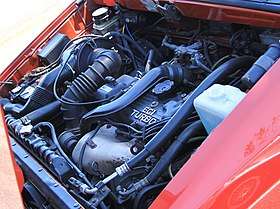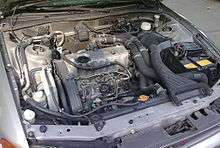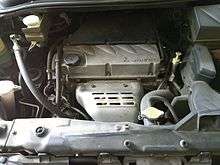Mitsubishi Sirius engine
The Mitsubishi Sirius or 4G6/4D6 engine is the name of one of Mitsubishi Motors' four series of inline-four automobile engines, along with Astron, Orion, and Saturn.
 | |
| Overview | |
| Manufacturer | Mitsubishi Motors |
| Also called | 4G6/4D6 |
| Production | 1976–2013 |
| Layout | |
| Configuration | Inline 4 |
| Displacement | 1.6 L; 97.3 cu in (1,595 cc) 1.8 L; 109.5 cu in (1,795 cc) 1.8 L; 112.0 cu in (1,836 cc) 2.0 L; 121.9 cu in (1,997 cc) 2.0 L; 121.9 cu in (1,998 cc) 2.4 L; 143.5 cu in (2,351 cc) 2.4 L; 145.1 cu in (2,378 cc) |
| Cylinder bore | 80.6 mm (3.17 in) 81.5 mm (3.21 in) 82.3 mm (3.24 in) 82.7 mm (3.26 in) 85 mm (3.35 in) 86.5 mm (3.41 in) 87 mm (3.43 in) |
| Piston stroke | 75 mm (2.95 in) 88 mm (3.46 in) 93 mm (3.66 in) 100 mm (3.94 in) |
| Block material | Cast iron |
| Head material | Aluminium |
| Valvetrain | SOHC & DOHC, 2 & 4 valves x cyl. with MIVEC (some versions) |
| Combustion | |
| Turbocharger | Some versions |
| Fuel system | Carburetor, Fuel injection |
| Fuel type | Gasoline, Diesel |
| Cooling system | Water-cooled |
| Chronology | |
| Successor | Mitsubishi 4B1 engine (Gasoline engine) Mitsubishi 4N1 engine (Diesel engine) |
The 4G6 gasoline engines were the favoured performance variant for Mitsubishi. The 4G61T powered their Colt Turbo, while the 4G63T, first introduced in the 1980 Lancer EX 2000 Turbo, went on to see service in the Sapporo and Starion coupés during the so-called "turbo era" of the 1980s, before creating for itself an illustrious motorsport heritage as the powerplant under the hood of the World Rally Championship-winning Lancer Evolution. A UK-market Evo known as the FQ400 had a 298 kW; 406 PS (400 bhp) version of the Sirius, making it the most powerful car ever sold by Mitsubishi.
The 4D6 diesel engines supplemented the larger 4D5. Bore pitch is 93 mm.
4G61
The 4G61 displaces 1,595 cc (1.6 L) with bore/ full length stroke of 82.3 mm × 75 mm (3.24 in × 2.95 in). This engine was always DOHC 16-valve and used either Multi-point (MPFI) or Electronic Control (ECFI) fuel injection. A turbocharged version was also produced for the Mirage and Lancer. The 4G61 does not have balance shafts like the other 4G6x motors.
Performance
- 4G61 105 hp (78 kW; 106 PS) at 6100 rpm.
- 4G61T (USA/Canada only) 135 hp (101 kW; 137 PS) at 6000 rpm and 191 N⋅m (141 lbf⋅ft) of torque at 3000 rpm.
- 4G61T (Japan) 145 hp (108 kW; 147 PS) at 6000 rpm and 220.65 N⋅m (163 lbf⋅ft) of torque at 2500 rpm.
Applications
- 1988–1992 Mitsubishi Mirage / Mitsubishi Colt (MPFI)
- 1988–1992 Dodge Colt / Plymouth Colt
- 1988–1992 Eagle Summit
- 1992–1995 Hyundai Elantra
4G62
The larger 1.8 L 4G62 was an SOHC 8-valve unit for longitudinal rear-wheel drive and all-wheel drive use. With a bore and stroke of 80.6 mm × 88 mm (3.17 in × 3.46 in), it displaces 1,795 cc (1.8 L). It was available either in carburetor form, multi-point fuel injection, or ECI Turbo as found in the Lancer EX 1800GSR or 1800GT, and Cordia GSR.
Applications
- 1980–1987 Mitsubishi Lancer EX 1800GSR or 1800GT (A175A)
- 1981–1986 Mitsubishi Delica/L300/Express
- 1983–1987 Mitsubishi Chariot HR
- 1983–1989 Mitsubishi Cordia
- 1983–1989 Mitsubishi Tredia
- 1984–1988 Mitsubishi Galant/Eterna
4G62T
Turbocharged version of the 4G62.
4G63/G63B

The 4G63 was a 1,997 cc (2.0 L) version.
Bore x stroke is 85 mm × 88 mm (3.35 in × 3.46 in) SOHC and DOHC were produced. Both versions were available in either naturally aspirated and turbocharged form. For front-wheel drive applications, the turbocharged Sirius' name was changed to "Cyclone Dash". As fitted to the fifth generation Galant 200 PS (147 kW; 197 bhp) JIS gross were claimed - the output claims later shrank to 170 PS (125 kW; 168 bhp) - for the turbocharged and intercooled "Sirius Dash 3x2 valve" engine. This version could switch between breathing through two or three valves per cylinder, to combine high top-end power with low-end drivability as well as allowing for economical operation.[1] It was a modification of Mitsubishi MCA-Jet technology which used a secondary intake valve to inject air into the engine for more efficient emissions control. The DOHC version was introduced in 1987 in the Japanese market Galant, and came in turbocharged or naturally aspirated form. It is found in various models including the 1988-92 Mitsubishi Galant VR-4, the U.S. market 1990-1999 Mitsubishi Eclipse, and the Mitsubishi Lancer Evolution I-IX. Later versions also received Mitsubishi's variable valve timing system, MIVEC.
A SOHC carbureted eight-valve version (engine code G63B) was also available in Mitsubishi's pickup trucks (L200, Strada, Mighty Max, Dodge Ram 50) from the eighties until the mid-nineties. It produces 92 hp (69 kW; 93 PS) at 5500 rpm in European trim (1989).[2] The SOHC version was also used in Mitsubishi Galant models until 1993. It has 76 kW (102 bhp; 103 PS) of output and 157 N⋅m (116 lbf⋅ft) of torque at 4,750 rpm.
Also, a SOHC version was produced until the late 90s and early 2000s and was used in Mitsubishi cars like the Montero and the 2.0 L 2-door Pajero with an output of 101 kW (137 PS; 135 bhp) at 4700 rpm. Also the N33 and N83 Spacewagon and Galant (UK market) received the 4G63, in single-cam sixteen-valve format. A similar version, with 100 PS (74 kW; 99 bhp), was also used in some light duty Mitsubishi Canters from 1997 on.[3]
The Mitsubishi Eclipse, Eagle Talon and Plymouth Laser introduced the DOHC turbocharged intercooled version to the U.S. in 1989 through Diamond Star Motors, a joint venture between Mitsubishi Motors and the Chrysler Corporation. From 1990 to late April 1992 came thicker connecting rods and the use of six bolts to secure the flywheel to the crankshaft; May 1992 to 2006 Evolution versions have lighter rods and use seven bolts to secure the flywheel to the crankshaft. They are referred to as the "six bolt" and "seven bolt" engines, respectively.
Output for the 2003 US Mitsubishi Lancer Evolution is 202 kW (271 bhp; 275 PS) at 6500 rpm with 370 N⋅m (273 lb⋅ft) of torque at 3500 rpm. It has a cast iron engine block and aluminum DOHC cylinder head. It uses multi-point fuel injection, has four valves per cylinder, is turbocharged and intercooled and features forged steel connecting rods.
The final version of the engine was found in Lancer Evolution IX. It was equipped with Mitsubishi's variable valve timing system, MIVEC. This version also had a revised turbocharger, extended reach spark plugs, two-piece rings.
Racing
Its turbocharged variant, G63T (also sometimes referred to simply as the 4G63), has powered Mitsubishi vehicles in World Rally Championships for years in the Mitsubishi Lancer EX 2000 Turbo, Mitsubishi Galant VR-4, Lancer Evolution, Carisma GT, and Lancer WRC04. It was the powerplant of the Lancer Evolution when Tommi Mäkinen won his four consecutive WRC championships in his Lancer. MHI and T-4 turbos were both used as power for these engines. A 1.7L variant of the 4G63 was also used in a custom made hill-climb McLaren F1(Known as McLaren F1 Evo) made by Komvet Racing.[4]
Applications
- 1981-1987 Mitsubishi Lancer EX 2000 Turbo
- 1997–2000 Mitsubishi Canter
- 1983-1998 Mitsubishi Chariot
- 1988 Mitsubishi Cordia
- 1985–1998 Mitsubishi Delica
- 1990–1999 Mitsubishi Eclipse
- 1980–2003 Mitsubishi Galant
- 1983-1989 Mitsubishi L200/Mighty Max
- 1992–2007 Mitsubishi Lancer Evolution
- 1993–1998 Mitsubishi Pajero
- 1994–1998 Mitsubishi RVR
- 1982–1987 Mitsubishi Starion
- 1988 Mitsubishi Tredia
- 2003-2005 Mitsubishi Airtrek
- 1999-2005 Mitsubishi Dion
- 2004–2010 Brilliance BS6
- 1983–1992 Dodge Colt Vista
- 1987-1989 Dodge Ram 50
- 1989-1992 Eagle Vista Wagon
- 1990–1998 Eagle Talon
- 1987-1988 Hyundai Stellar - Engine also called : Hyundai Sirius engine (G4CP)
- 1992-2005 Hyundai Sonata - Engine also called : Hyundai Sirius engine (G4CP)
- 1998-2003 Hyundai Santamo - Engine also called : Hyundai Sirius engine (G4CP)
- 2000-2008 Hyundai SantaFe - Engine also called : Hyundai Sirius engine (G4JS)
- 2000-2004 Kia Joice - Engine also called : Hyundai Sirius engine (G4CP)
- 1990–1994 Plymouth Laser
- 1985 Proton Saga (Prototype)
- 1996–1999 Proton Perdana
- 2011–present Landwind X8 4X2 2.0
- 2005-2015 Great Wall Haval H3
- 2007-2015 Great Wall Coolbear
- 2006 - 2007 Lancer GT 2.0
- 2006 Brilliance BS4
- 2009 Landwind X6
- 2016–2017 Landwind X7
- 2014–2016 Zotye T600
- 2016–present Zotye T700
- 2017–present Zotye SR9
- 2018–present Beijing BJ2022 Brave Warrior
- 2011-2012 and some 2013 Emgrand EC8
4G64
The 4G64 is the second largest variant, at 2,351 cc (2.4 L). Early models were 8-valve SOHC, but a later 16-valve SOHC and DOHC version was also produced. All used MPFI and had an bore and stroke of 86.5 mm × 100 mm (3.41 in × 3.94 in). The 4G64 was later also available with gasoline direct injection. Output varies between 155 hp (116 kW; 157 PS) at 5,250 rpm with 163 lb⋅ft (221 N⋅m) of torque at 4,000 rpm in the Mitsubishi L200 and 152 hp (113 kW; 154 PS) at 5,500 rpm with 163 lb⋅ft (221 N⋅m) of torque at 4,000 rpm in the Chrysler Sebring/Stratus. The Chrysler version features fracture-split forged powder metal connecting rods. The DOHC and SOHC 16V 4G64 are interference engines, while the SOHC 8V 4G64 is a non interference engine. From March 1996 an LPG version with 115 hp (86 kW; 117 PS) at 5,000 rpm was available in the Mitsubishi Canter.[3]
Applications
- 1993-1997 Mitsubishi Chariot
- 1988–2006 Mitsubishi Delica/Van
- 1997-1999 Mitsubishi Eclipse
- 1997-1999 Mitsubishi Montero Sport (North American, ES model)
- 2000-2005 Mitsubishi Eclipse
- 1994–2003 Mitsubishi Galant
- 1990–present Mitsubishi L200
- 1996–1998 Mitsubishi Magna (codenamed 4G64-S4 and fitted to the TE-TF series)
- 1990–1996 Mitsubishi Mighty Max
- 1998-2005 Mitsubishi Montero (V11 - 2 door) Latin America version
- 2001 Mitsubishi Airtrek
- 2003 Mitsubishi Outlander
- 1987–1990 Mitsubishi Sapporo
- 1986-2005 Mitsubishi Triton
- 2005 Mitsubishi Zinger
- 2003-2006 Kia Sorento 2.4i Manual
- 2004 Brilliance BS6
- 2008–present Chery V5
- 2001-2004 Dodge Stratus Coupe
- 1983–1992 Dodge Colt Vista (AWD only)
- 1990–1992 Dodge Ram 50
- 2006–present Great Wall Hover(X240 and V240)
- 2004–2015 Hyundai Terracan
- 1986-1998 Hyundai Grandeur
- 1989–1991 Hyundai Sonata
- 1999–2005 Hyundai Sonata
- 2001-2006 Hyundai Santa Fe
- 2000–2005 Kia Optima
- 1998–2003 Mitsubishi Space Wagon
- 2016- Landwind X6
- 2004- Mitsubishi Space Wagon
- 2002–present Changfeng Liebao (a series of cars based on the Mitsubishi Pajero V20 from China)
4G64T
Turbocharged version of the 4G64.
4D65
Known as the "Sirius Diesel", the 4D65 had the same dimensions as the 4G62 1,795 cc (1.8 L). It was available either naturally aspirated or turbocharged (with an air-to-air intercooler), and was used in most Mitsubishi diesel passenger cars in the eighties and beginning of the nineties. It was developed specifically to be transversally installed in front-wheel-drive cars, unlike the preceding 4D5-series which remained in production for commercial vehicles. The 1.8 TD power figures were comparable to those of the 22% larger 2.3 TD 4D55, with more low-down torque and while being much smoother.[5] The cast-iron block was typical for Mitsubishi, but unusual for diesel engines, in being equipped with balance shafts.[6] A number of installations combined this engine with four-wheel-drive. Some period critics were doubtful of the durability of the turbocharged engine, as the charger would spool up immediately (many turbodiesels have a thermostat which only allows the turbo to engage once the engine has warmed up) and a very short pre-heating period, leading to lots of noise and smoke in cold weather starts.[5]
Applications
- 4D65 (naturally aspirated)
- 1983–1987 Mitsubishi Mirage/Colt/Lancer (C14)
- 1985–1992 Mitsubishi Mirage/Lancer Van/Wagon (C14/C34)
- 1987–1991 Mitsubishi Mirage/Colt/Lancer (C64/C74)
- 4D65T (turbocharged)
- 1983-1989 Mitsubishi Galant/Galant Σ/Eterna Σ (E14)
- 1984-1991 Mitsubishi Chariot/Space Wagon (D09W)
- 1987-1992 Mitsubishi Galant/Eterna (E34)
- 1988–1991 Mitsubishi Lancer (C74, 4WD sedan only)
- 1991–1995 Mitsubishi Lancer/Mirage/Libero (CB7, CD7)
4G67
The 16-valve DOHC 4G67 displaced 1,836 cc (1.8 L). Bore x Stroke: 81.5 mm × 88 mm (3.21 in × 3.46 in)
Applications
- 1989-1992 Colt/Lancer 1.8 GTI (C58A/C68A)
- 1989-1992 Mitusbishi Galant/Eterna (E35A)
- 1993-1995 Hyundai Elantra, this engine was called G4CN by Hyundai
4D68

Known as the "Sirius Diesel", the 4D68 version displaced 1,998 cc (2.0 L). It was fitted with a 93 mm (3.66 in) stroke crankshaft and the cylinder bore diameter was 82.7 mm (3.26 in). This engine used pistons with a static compression ratio of 22.4:1 and piston pins were 25 mm (0.98 in) OD. It was available either naturally aspirated or turbocharged, and replaced the 4D65 as Mitsubishi's "go-to" diesel.
- Type : Diesel engine
- Number of cylinders: Inline 4
- Combustion chamber: Swirl chamber
- Lubrication system: Pressure feed, full-flow filtration
- Oil pump type: External gear type
- Cooling system: Water-cooled
- Water pump type: Centrifugal impeller type
- EGR type: Single type
- Fuel system: Electronic control distributor-type injection pump
- Supercharging: Turbocharger
- Rocker arm: Roller type
Applications
- 1991-1996 Mitsubishi Mirage/Colt
- 1991-1996 Mitsubishi Lancer/Libero
- 1992-1997 Mitsubishi Chariot/Space Wagon
- 1996-2000 Mitsubishi Galant/Galant Break(Legnum)
- 1996-1999 Mitsubishi Lancer/Libero
- 1997-2002 Mitsubishi Mirage/Colt
- 1995-2000 Proton Wira 2.0D
- 2007-2008 Mitsubishi Triton/L200
4G69

The 4G69 is a 2,378 cc (2.4 L) version built in Shiga, Japan and Shenyang, China. Bore and stroke is 87 mm × 100 mm (3.43 in × 3.94 in). Output is 120 kW (161 hp; 163 PS) at 5750 rpm (160 in the Sportback Wagon) with 219 N⋅m (162 lb⋅ft) of torque at 3500 rpm. It has a cast iron engine block (later switch to aluminum block) and an aluminum SOHC cylinder head. It uses multi-point fuel injection, has 4 valves per cylinder with roller followers and features forged steel connecting rods, a one-piece cast camshaft, and a cast aluminum intake manifold. The 4G69 incorporates Mitsubishi's MIVEC Variable Valve Timing technology.
Mitsubishi ceased any further development and production of Sirius engine after 2012 model year, and its joint-venture, Shenyang Aerospace Mitsubishi Motors Engine Manufacturing Co., in China is now the only one producing 4A9 engines (improved to aluminum block while adding timing chain) for the Chinese market.
Applications
- 2003–2008 Mitsubishi Pajero Sport (China)
- 2003–2011 Mitsubishi Grandis
- 2004–2006 Mitsubishi Lancer
- 2004–2006 Mitsubishi Outlander
- 2004–2012 Mitsubishi Galant
- 2006–2012 Great Wall Wingle 3
- 2006–2012 Mitsubishi Eclipse
- 2008–present Mitsubishi Zinger for automatic models only
- 2008-2013 Great Wall Haval H3
- 2009–present Great Wall Haval H5
- 2010–present Great Wall Wingle 5
- 2011–2013 BYD S6
- 2012–present JMC Yuhu
NB: From 2005 a slightly detuned version developing 115 kW (154 hp; 156 PS) and 220 N⋅m (162 lbf⋅ft) is used across the entire Lancer range in Australia.
- 2011–2014 Emgrand EC8
- Of further note, the Great Wall Haval uses a completely detuned variant offering only 100 kW (134 hp; 136 PS) and 200 N⋅m (148 lbf⋅ft)
- 2014–present Great Wall Wingle 6
- 2009–2015 Great Wall Coolbear
- 2015–2016 Landwind X6
- 2006–2013 Zhongxing Landmark
- 2014–present Maxus G10
- 2019–present CMC Mitsubishi Delica Van/Pickup
See also
- List of Mitsubishi engines
- List of Hyundai engines
- List of engines used in Chrysler products
External links
| Wikimedia Commons has media related to Toyota U engines. |
References
- Yamaguchi, Jack K. (1985), Lösch, Annamaria (ed.), "Japan: Lucrative Contraction", World Cars 1985, Pelham, NY: The Automobile Club of Italy/Herald Books: 51, ISBN 0-910714-17-7
- Mitsubishi Motors: Commercial Vehicle Range (brochure), Cirencester, Glos., UK: The Colt Car Company, 1989, p. 12
- Takayoshi, Seiji (高吉 誠司), ed. (2011-03-17), "トラックメーカーアーカイブ vol.2: 三菱ふそうのすべて [Truck Manufacturer Archive Volume 2: Everything Mitsubishi Fuso]", Camion (in Japanese), Tokyo, Japan: Geibun Mooks (780), p. 66, ISBN 978-4-86396-112-8
- HillClimb Monsters (2019-05-01), McLaren F1 Evo with 1.7L Turbo Mitsubishi Engine || 600Hp/710Kg Monster, retrieved 2019-05-13
- De Leener, Philippe (1985-01-24). "Essai detaillé: Mitsubishi Galant 1.8 TD" [Detailed Test]. Le Moniteur de l'Automobile (in French). Brussels, Belgium: Editions Auto-Magazine. 36 (813): 123.
- De Leener, p. 122
- http://www.redbook.com.au/cars/research/used/details/2010-great-wall-x240-manual-4x4/SPOT-ITM-225879
- "Engine Epic Part 8 - Mitsubishi Engines", Michael Knowling, Autospeed, issue 48, 21 September 1999
| Wikimedia Commons has media related to Mitsubishi 4G6 engines. |